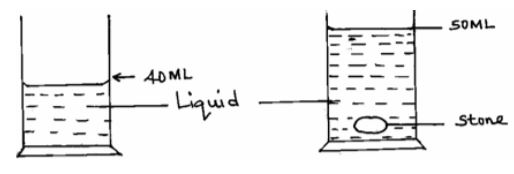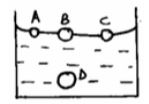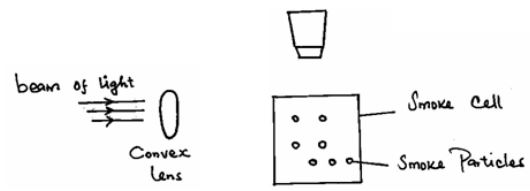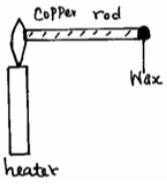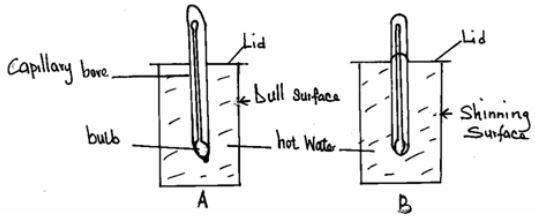Questions
INSTRUCTIONS TO CANDIDATES:
- The paper consist of two Sections A and B. Answer all the questions in the spaces provided.
- Mathematical tables may be used.
SECTION A - (40 MARKS)
- Define the term physics. (1 mark)
- State three career opportunities related to physics. (3 marks)
- The table below shows some basic quantities and their SI units. Complete the table to show the missing entries. (2 marks)
Quantity S.I Unit Symbols 1 Candela 2 Amount of substances - A stone of mass, 40g was completely immersed in a liquid. The levels of the liquids are shown in the figure.
Determine the density of the stone in SI unit. (2 marks) -
- One of the factors that affect surface tension is temperature of the liquid. State one other factor. (1 mark)
- Use surface molecules A, B, C and inner molecule D shown below, to explain why surface of a liquid is under tension. (2 marks)
- Name two forces that determine the shape of a liquid drop on a solid surface. (2 marks)
- 1800cm3 of fresh water of density 1000kg/m3 is mixed with 2200cm3 of sea water of density 1025kg/m3. Calculate the density of the mixture (4mks)
- State the reason why it may not be possible to suck a liquid in to your mouth using a drinking straw in the surface of the moon. (1 mark)
- In building construction, beans made of concrete are reinforced with steel. Explain. (2 marks)
- When a liquid is heated in a glass flask, its level first falls and then rises. Explain this observation. (2 marks)
- Name the thermometric liquid that is most suitable to use in very cold places. (1 mark)
-
- State one factor which makes gases compressible. (1 mark)
- The figure below shows a set up used to demonstrate Brownian motion in gases.
State the role of the; (3 marks)- Convex lens.
- Microscope.
- Beam of light.
- Define the term diffusion. (1 mark)
- Highlight two factors which shows that heat from the sun does reach the earth surface by convection. (2 marks)
- The figure below shows some wax at the end of a copper rod.
State three factors that affect the rate at which the wax melts. (3 marks)
- The figure below shows some wax at the end of a copper rod.
-
- Define force and give its S.I units (2mks)
- State three effects of force on an object (3mks)
- Name and show forces acting on a box placed on a table. (2mks)
SECTION B - (30 MARKS)
- A ream of foolscaps containing 500 papers has a thickness of 50mm and a mass of 2kg. if it has a width of 200mm and a length of 300mm, find;
- The thickness of one sheet of paper (2 marks)
- The mass of one sheet of paper (2 marks)
- The volume of one sheet of paper (3 marks)
- The density of the paper. (3 marks)
-
- Two identical aluminium rods shown in the figure below are heated by the same Bunsen burner. One rests on a metal block and the other on a wooden block.
State with a reason which wax is likely to melt. (2 marks) - Two identical cans A and B were each filled with hot water at the same temperature and covered with an air tight lid as shown below.
Given that the outer surface of can A is dull while that of B is shiny, state with a reason which thermometer would show lower temperature after ten minutes. (2 marks) - State the purpose of the following features of a thermometer. (3 marks)
- Narrow capillary bore.
- Thin bulb.
- Thick glass stem.
- State three properties of mercury that makes it a good thermometric liquid. (3 marks)
- Two identical aluminium rods shown in the figure below are heated by the same Bunsen burner. One rests on a metal block and the other on a wooden block.
- States the reason why it is not correct to quote the weight of solid objects in kilograms. (1 mk)
- Wasike found that the width of his desk was approximately 10 palm-lengths. If his palm was 15.0cm long, what was the width of his desk in metres? (3 mks)
- Describe how to estimate the height of a tree using a rod of about 2m long and a tape measure.(3 mks)
- The mass of an empty density bottle is 20g its mass when filled with water is 40.0g and 50.0 when filled with liquid x. Calculate the density of liquid X if the density of water is 1000kgm-3. (3 mks)
Marking Scheme
SECTION A - 40 MKS
- The study of matter in relation to energy. 1 mk
- Career opportunities.
- Engineering (mechanical, electrical, civil, electronics etc)
- Physics teacher
- Pilot.
- Computer scientist.
- Surveyor. (any other relevant) (any three) (1 x 3)
-
Both correct - one mark.Quantity S.I unit Symbols Luminous intensity Candela Cd Amount of substances Mole Mol
only one correct – zero - m = 40 g or m = 40 g
= 0.04 kg r = (50 - 40)
v = 50 - 40 = 10 ml
= 10 ml = 10 cm3
= 0.0000 1 m3
ζ = 0.04 ζ = 40 = 4 gcm -3
0.00001 10
= 4000 kg /m3 = 4,000 kgm-3 -
- Presence of impurities.
- Molecule D experiences equal forces in all directions hence zero resultant force. The surface molecules A, B and D are only pulled inwards and no outward force for balancing hence under tension.
-
- Adhesive force.
- Cohesive force.
- Density of mixture = mass of mixture
Volume of mixture
Mass of fresh water = 1800 x 1 =1800g
Mass of sea water = 2200 x 1.025 = 2255g
Density of mixture = 2255 + 1800
1800 + 2200
= 1.01375g/cm3 - Absence of atmospheric pressure.
- Concrete and steel have the same linear expansivity. They expand and contract at the same rate without breaking.
- The flask receives the heat first and expands increasing its capacity later the heat reaches the liquid which expands at a faster rate than the glass.
- Alcohol..
-
- Large intermolecular distances.
-
- To focus light into the smoke cell.
- To magnify the smoke particles.
- To illuminate the smoke particles to make them more visible.
- Movement of molecules from a region of high concentration to a region of low concentration.
-
- Convection requires a medium but between the sun and the atmosphere there is a vacuum.
- Hot particles move upwards from the source.
-
- Length of the rod.
- Thickness / cross-section area of the rod.
- Temperature difference.
(reject type of motorial & amount of heat produced by the heater)
-
- Force is defined as a pull or a push S.I units = Newton (N)
-
- can make objects change direction of motion
- Can make a stationary object start moving or increase the sped of moving object/cause acceleration
- Slows down or stop a moving object
- Distort (change shape) of an object
-
- thickness = 50/100
0.1mm - mass= 2000 = 4g
500 - Colume = 5 x 20 x30 = 6cm3
500 - density = 4/6 = 0.67g/cm3
- thickness = 50/100
-
- Wax B - Wood is a poor conductor and all the heat absorbed by the rod is used for melting the wax but the metal block conducts all the heat away.
- Thermometer A
Dull surfaces are better emitters of heat that shinny surfaces. -
- To make thermometer more accurate / sensitive.
- Quick acting /quick transmission of heat, to the mercury.
- To magnify the scale.
-
- Has uniform expansitity.
- Has does not wet the surface.
- It is visible/opaque.
- Good conductor of heat.
- Has wide range of temperature
- Very sensitive to heat. (any three)
- The S.I. unit of measuring weight is Newton and not Kilogram.
-
- 1 palm – Length is 15cm long
10 palm – lengths
= (10 x 15)cm
= 150 = 1.5m
100
- 1 palm – Length is 15cm long
-
- Hold the rod upright and measure its length using the tape measure.
- Measure the length of its shadow
- Measure the length of the shadow of a tree in the school compound
- Then relate the height of the tree from:
Height of tree
Height of rod
= Length of the shadow of the tree
Length of the shadow of the rod
-
- Mass of H2O - 40 – 20 = 20g = 0.02kg
Density of H2O – 1000kg
Volume of H2O = 0.02
1000
= 0.00002m3
Mass of liquid x 50g – 20g = 30g = 0.03kg
Volume = -0002
Density of liquid = 1500kg/m3
- Mass of H2O - 40 – 20 = 20g = 0.02kg
Join our whatsapp group for latest updates
Tap Here to Download for 50/-
Get on WhatsApp for 50/-
Download Physics Questions and Answers - Form 1 End Term 2 Exams 2022.
Tap Here to Download for 50/-
Get on WhatsApp for 50/-
Why download?
- ✔ To read offline at any time.
- ✔ To Print at your convenience
- ✔ Share Easily with Friends / Students

